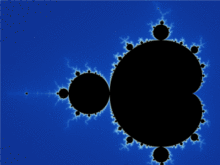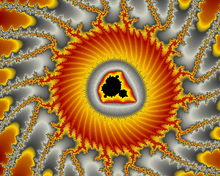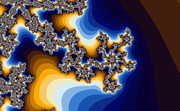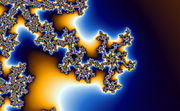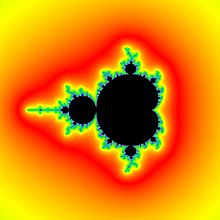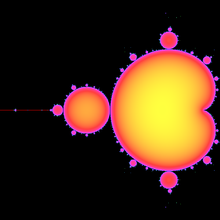- Mandelbrot set
-
The Mandelbrot set is a particular mathematical set of points, whose boundary generates a distinctive and easily recognisable two-dimensional fractal shape. The set is closely related to the Julia set (which generates similarly complex shapes), and is named after the mathematician Benoît Mandelbrot, who studied and popularized it.
More technically, the Mandelbrot set is the set of values of c in the complex plane for which the orbit of 0 under iteration of the complex quadratic polynomial zn+1 = zn2 + c remains bounded.[1] That is, a complex number, c, is part of the Mandelbrot set if, when starting with z0 = 0 and applying the iteration repeatedly, the absolute value of zn remains bounded however large n gets.
For example, letting c = 1 gives the sequence 0, 1, 2, 5, 26,…, which tends to infinity. As this sequence is unbounded, 1 is not an element of the Mandelbrot set. On the other hand, c = i (where i is defined as i2 = −1) gives the sequence 0, i, (−1 + i), −i, (−1 + i), −i, ..., which is bounded and so i belongs to the Mandelbrot set.
Images of the Mandelbrot set display an elaborate boundary that reveals progressively ever-finer recursive detail at increasing magnifications. The "style" of this repeating detail depends on the region of the set being examined. The set's boundary also incorporates smaller versions of the main shape, so the fractal property of self-similarity applies to the entire set, and not just to its parts.
The Mandelbrot set has become popular outside mathematics both for its aesthetic appeal and as an example of a complex structure arising from the application of simple rules, and is one of the best-known examples of mathematical visualization.
Contents
History
The Mandelbrot set has its place in complex dynamics, a field first investigated by the French mathematicians Pierre Fatou and Gaston Julia at the beginning of the 20th century. The first pictures of this fractal were drawn in 1978 by Robert Brooks and Peter Matelski as part of a study of Kleinian groups.[2] On 1 March 1980, at IBM's Thomas J. Watson Research Center in upstate New York, Benoît Mandelbrot first saw a visualization of the set.[3]
Mandelbrot studied the parameter space of quadratic polynomials in an article that appeared in 1980.[4] The mathematical study of the Mandelbrot set really began with work by the mathematicians Adrien Douady and John H. Hubbard,[5] who established many of its fundamental properties and named the set in honour of Mandelbrot.
The mathematicians Heinz-Otto Peitgen and Peter Richter became well-known for promoting the set with photographs, books,[6] and an internationally touring exhibit of the German Goethe-Institut.[7][8]
The cover article of the August 1985 Scientific American introduced the algorithm for computing the Mandelbrot set to a wide audience. The cover featured an image created by Peitgen, et al.[9][10]
The work of Douady and Hubbard coincided with a huge increase in interest in complex dynamics and abstract mathematics, and the study of the Mandelbrot set has been a centerpiece of this field ever since. An exhaustive list of all the mathematicians who have contributed to the understanding of this set since then is beyond the scope of this article, but such a list would notably include Mikhail Lyubich,[11][12] Curt McMullen, John Milnor, Mitsuhiro Shishikura, and Jean-Christophe Yoccoz.
Formal definition
The Mandelbrot set M is defined by a family of complex quadratic polynomials
given by
where c is a complex parameter. For each c, one considers the behavior of the sequence
obtained by iterating Pc(z) starting at critical point z = 0, which either escapes to infinity or stays within a disk of some finite radius. The Mandelbrot set is defined as the set of all points c such that the above sequence does not escape to infinity.
More formally, if
 denotes the nth iterate of Pc(z) (i.e. Pc(z) composed with itself n times), the Mandelbrot set is the subset of the complex plane given by
denotes the nth iterate of Pc(z) (i.e. Pc(z) composed with itself n times), the Mandelbrot set is the subset of the complex plane given byAs explained below, it is in fact possible to simplify this definition by taking s = 2.
Mathematically, the Mandelbrot set is just a set of complex numbers. A given complex number c either belongs to M or it does not. A picture of the Mandelbrot set can be made by colouring all the points c which belong to M black, and all other points white. The more colourful pictures usually seen are generated by colouring points not in the set according to how quickly or slowly the sequence
 diverges to infinity. See the section on computer drawings below for more details.
diverges to infinity. See the section on computer drawings below for more details.The Mandelbrot set can also be defined as the connectedness locus of the family of polynomials Pc(z). That is, it is the subset of the complex plane consisting of those parameters c for which the Julia set of Pc is connected.
Basic properties
The Mandelbrot set is a compact set, contained in the closed disk of radius 2 around the origin. In fact, a point c belongs to the Mandelbrot set if and only if
 for all
for all  .
.
In other words, if the absolute value of
 ever becomes larger than 2, the sequence will escape to infinity.
ever becomes larger than 2, the sequence will escape to infinity.The intersection of M with the real axis is precisely the interval [-2, 0.25]. The parameters along this interval can be put in one-to-one correspondence with those of the real logistic family,
The correspondence is given by
In fact, this gives a correspondence between the entire parameter space of the logistic family and that of the Mandelbrot set.
The area of the Mandelbrot set is estimated to be 1.50659177 ± 0.00000008.[13]
Douady and Hubbard have shown that the Mandelbrot set is connected. In fact, they constructed an explicit conformal isomorphism between the complement of the Mandelbrot set and the complement of the closed unit disk. Mandelbrot had originally conjectured that the Mandelbrot set is disconnected. This conjecture was based on computer pictures generated by programs which are unable to detect the thin filaments connecting different parts of M. Upon further experiments, he revised his conjecture, deciding that M should be connected.
The dynamical formula for the uniformisation of the complement of the Mandelbrot set, arising from Douady and Hubbard's proof of the connectedness of M, gives rise to external rays of the Mandelbrot set. These rays can be used to study the Mandelbrot set in combinatorial terms and form the backbone of the Yoccoz parapuzzle.[14]
The boundary of the Mandelbrot set is exactly the bifurcation locus of the quadratic family; that is, the set of parameters c for which the dynamics changes abruptly under small changes of c. It can be constructed as the limit set of a sequence of plane algebraic curves, the Mandelbrot curves, of the general type known as polynomial lemniscates. The Mandelbrot curves are defined by setting p0=z, pn=pn-12+z, and then interpreting the set of points |pn(z)|=2 in the complex plane as a curve in the real Cartesian plane of degree 2n+1 in x and y.
Other properties
The main cardioid and period bulbs
Upon looking at a picture of the Mandelbrot set, one immediately notices the large cardioid-shaped region in the center. This main cardioid is the region of parameters c for which Pc has an attracting fixed point. It consists of all parameters of the form
for some μ in the open unit disk.
To the left of the main cardioid, attached to it at the point c = − 3 / 4, a circular-shaped bulb is visible. This bulb consists of those parameters c for which Pc has an attracting cycle of period 2. This set of parameters is an actual circle, namely that of radius 1/4 around -1.
There are infinitely many other bulbs tangent to the main cardioid: for every rational number
 , with p and q coprime, there is such a bulb that is tangent at the parameter
, with p and q coprime, there is such a bulb that is tangent at the parameter
This bulb is called the
 -bulb of the Mandelbrot set. It consists of parameters which have an attracting cycle of period q and combinatorial rotation number
-bulb of the Mandelbrot set. It consists of parameters which have an attracting cycle of period q and combinatorial rotation number  . More precisely, the q periodic Fatou components containing the attracting cycle all touch at a common point (commonly called the α-fixed point). If we label these components
. More precisely, the q periodic Fatou components containing the attracting cycle all touch at a common point (commonly called the α-fixed point). If we label these components  in counterclockwise orientation, then Pc maps the component Uj to the component
in counterclockwise orientation, then Pc maps the component Uj to the component  .
. Cycle periods and antennae
Cycle periods and antennae
The change of behavior occurring at
 is known as a bifurcation: the attracting fixed point "collides" with a repelling period q-cycle. As we pass through the bifurcation parameter into the
is known as a bifurcation: the attracting fixed point "collides" with a repelling period q-cycle. As we pass through the bifurcation parameter into the  -bulb, the attracting fixed point turns into a repelling fixed point (the α-fixed point), and the period q-cycle becomes attracting.
-bulb, the attracting fixed point turns into a repelling fixed point (the α-fixed point), and the period q-cycle becomes attracting.Hyperbolic components
All the bulbs we encountered in the previous section were interior components of the Mandelbrot set in which the maps Pc have an attracting periodic cycle. Such components are called hyperbolic components.
It is conjectured that these are the only interior regions of M. This problem, known as density of hyperbolicity, may be the most important open problem in the field of complex dynamics. Hypothetical non-hyperbolic components of the Mandelbrot set are often referred to as "queer" components.[citation needed]
For real quadratic polynomials, this question was answered positively in the 1990s independently by Lyubich and by Graczyk and Świątek. (Note that hyperbolic components intersecting the real axis correspond exactly to periodic windows in the Feigenbaum diagram. So this result states that such windows exist near every parameter in the diagram.)
Not every hyperbolic component can be reached by a sequence of direct bifurcations from the main cardioid of the Mandelbrot set. However, such a component can be reached by a sequence of direct bifurcations from the main cardioid of a little Mandelbrot copy (see below).
Each of the hyperbolic components has a centre, namely the point c such that the inner Fatou domain for Pc(z) has a super-attracting cycle (the attraction is infinite). This means that the cycle contains the critical point 0, so that 0 is iterated back to itself after some iterations. We therefore have that Pcn(0) = 0 for some n. If we call this polynomial Qn(c) (letting it depend on c instead of z), we have that Qn + 1(c) = Qn(c)2 + c and that the degree of Qn(c) is 2n − 1. We can therefore construct the centres of the hyperbolic components, by successive solvation of the equations Qn(c) = 0,n = 1,2,3,.... Note that for each step, we get just as many new centres as we have found so far.
Local connectivity
It is conjectured that the Mandelbrot set is locally connected. This famous conjecture is known as MLC (for Mandelbrot Locally Connected). By the work of Adrien Douady and John H. Hubbard, this conjecture would result in a simple abstract "pinched disk" model of the Mandelbrot set. In particular, it would imply the important hyperbolicity conjecture mentioned above.
The work of Jean-Christophe Yoccoz[citation needed]established local connectivity of the Mandelbrot set at all finitely-renormalizable parameters; that is, roughly speaking those which are contained only in finitely many small Mandelbrot copies. Since then, local connectivity has been proved at many other points of M, but the full conjecture is still open.
Self-similarity
 Self similarity in the Mandelbrot set shown by zooming in on a round feature while panning in the negative-x direction. The display center pans from (−1, 0) to (−1.31, 0) while the view magnifies from 0.5 × 0.5 to 0.12 × 0.12 to approximate the Feigenbaum ratio δ.
Self similarity in the Mandelbrot set shown by zooming in on a round feature while panning in the negative-x direction. The display center pans from (−1, 0) to (−1.31, 0) while the view magnifies from 0.5 × 0.5 to 0.12 × 0.12 to approximate the Feigenbaum ratio δ.
The Mandelbrot set is self-similar under magnification in the neighborhoods of the Misiurewicz points. It is also conjectured to be self-similar around generalized Feigenbaum points (e.g. −1.401155 or −0.1528 + 1.0397i), in the sense of converging to a limit set.[15][16]
The Mandelbrot set in general is not strictly self-similar but it is quasi-self-similar, as small slightly different versions of itself can be found at arbitrarily small scales.
The little copies of the Mandelbrot set are all slightly different, mostly because of the thin threads connecting them to the main body of the set.
Further results
The Hausdorff dimension of the boundary of the Mandelbrot set equals 2 as determined by a result of Mitsuhiro Shishikura.[17] It is not known whether the boundary of the Mandelbrot set has positive planar Lebesgue measure.
In the Blum-Shub-Smale model of real computation, the Mandelbrot set is not computable, but its complement is computably enumerable. However, many simple objects (e.g., the graph of exponentiation) are also not computable in the BSS model. At present it is unknown whether the Mandelbrot set is computable in models of real computation based on computable analysis, which correspond more closely to the intuitive notion of "plotting the set by a computer." Hertling has shown that the Mandelbrot set is computable in this model if the hyperbolicity conjecture is true.
 Map of Julia sets for points on the complex plane. The overall structure, in terms of which Julia sets are connected, resembles a Mandelbrot set.
Map of Julia sets for points on the complex plane. The overall structure, in terms of which Julia sets are connected, resembles a Mandelbrot set.
Relationship with Julia sets
As a consequence of the definition of the Mandelbrot set, there is a close correspondence between the geometry of the Mandelbrot set at a given point and the structure of the corresponding Julia set.
This principle is exploited in virtually all deep results on the Mandelbrot set. For example, Shishikura proves that, for a dense set of parameters in the boundary of the Mandelbrot set, the Julia set has Hausdorff dimension two, and then transfers this information to the parameter plane.[citation needed] Similarly, Yoccoz first proves the local connectivity of Julia sets, before establishing it for the Mandelbrot set at the corresponding parameters.[citation needed] Adrien Douady phrases this principle as
Plough in the dynamical plane, and harvest in parameter space.
Geometry
Recall that, for every rational number
 , where p and q are relatively prime, there is a hyperbolic component of period q bifurcating from the main cardioid. The part of the Mandelbrot set connected to the main cardioid at this bifurcation point is called the p/q-limb. Computer experiments suggest that the diameter of the limb tends to zero like
, where p and q are relatively prime, there is a hyperbolic component of period q bifurcating from the main cardioid. The part of the Mandelbrot set connected to the main cardioid at this bifurcation point is called the p/q-limb. Computer experiments suggest that the diameter of the limb tends to zero like  . The best current estimate known is the famous Yoccoz-inequality, which states that the size tends to zero like
. The best current estimate known is the famous Yoccoz-inequality, which states that the size tends to zero like  .
.A period-q limb will have q − 1 "antennae" at the top of its limb. We can thus determine the period of a given bulb by counting these antennas.
In an attempt to demonstrate that the thickness of the p/q-limb is zero, David Boll carried out a computer experiment in 1991, where he computed the number of iterations required for the series to converge for z =
 (
( being the location thereof). As the series doesn't converge for the exact value of z =
being the location thereof). As the series doesn't converge for the exact value of z =  , the number of iterations required increases with a small ε. It turns out that multiplying the value of ε with the number of iterations required yields an approximation of π that becomes better the smaller ε. For example, for ε = 0.0000001 the number of iterations is 31415928 and the product is 3.1415928.[18]
, the number of iterations required increases with a small ε. It turns out that multiplying the value of ε with the number of iterations required yields an approximation of π that becomes better the smaller ε. For example, for ε = 0.0000001 the number of iterations is 31415928 and the product is 3.1415928.[18]Image gallery of a zoom sequence
The Mandelbrot set shows more intricate detail the closer one looks or magnifies the image, usually called "zooming in". The following example of an image sequence zooming to a selected c value gives an impression of the infinite richness of different geometrical structures, and explains some of their typical rules.
The magnification of the last image relative to the first one is about 10,000,000,000 to 1. Relating to an ordinary monitor, it represents a section of a Mandelbrot set with a diameter of 4 million kilometres. Its border would show an astronomical number of different fractal structures.
The seahorse "body" is composed by 25 "spokes" consisting of two groups of 12 "spokes" each and one "spoke" connecting to the main cardioid. These two groups can be attributed by some kind of metamorphosis to the two "fingers" of the "upper hand" of the Mandelbrot set; therefore, the number of "spokes" increases from one "seahorse" to the next by 2; the "hub" is a so-called Misiurewicz point. Between the "upper part of the body" and the "tail" a distorted small copy of the Mandelbrot set called satellite may be recognized.
-
Part of the "tail" — there is only one path consisting of the thin structures that lead through the whole "tail". This zigzag path passes the "hubs" of the large objects with 25 "spokes" at the inner and outer border of the "tail"; thus the Mandelbrot set is a simply connected set, which means there are no islands and no loop roads around a hole.
-
Satellite. The two "seahorse tails" are the beginning of a series of concentric crowns with the satellite in the center. Open this location in an interactive viewer.
-
In the outer part of the appendices islands of structures may be recognized; they have a shape like Julia sets Jc; the largest of them may be found in the center of the "double-hook" on the right side.
The islands above seem to consist of infinitely many parts like Cantor sets, as is[clarification needed] actually the case for the corresponding Julia set Jc. However they are connected by tiny structures so that the whole represents a simply connected set. The tiny structures meet each other at a satellite in the center that is too small to be recognized at this magnification. The value of c for the corresponding Jc is not that of the image center but, relative to the main body of the Mandelbrot set, has the same position as the center of this image relative to the satellite shown in the 7th zoom step.
Generalizations
Multibrot sets are bounded sets found in the complex plane for members of the general monic univariate polynomial family of recursions
For integer d, these sets are connectedness loci for the Julia sets built from the same formula. The full cubic connectedness map has also been studied; here one considers the two-parameter recursion
 , whose two critical points are the complex square roots of the parameter k. A point is in the map if either critical point is stable.[19]
, whose two critical points are the complex square roots of the parameter k. A point is in the map if either critical point is stable.[19]For general families of holomorphic functions, the boundary of the Mandelbrot set generalizes to the bifurcation locus, which is a natural object to study even when the connectedness locus is not useful.
Other non-analytic mappings
Of particular interest is the tricorn fractal, the connectedness locus of the anti-holomorphic family
The tricorn (also sometimes called the Mandelbar set) was encountered by Milnor in his study of parameter slices of real cubic polynomials. It is not locally connected. This property is inherited by the connectedness locus of real cubic polynomials.
Another non-analytic generalization is the Burning Ship fractal which is obtained by iterating the mapping
The Multibrot set is obtained by varying the value of the exponent d. The article has a video that shows the development from d = 0 to 7 at which point there are 6 i.e. (d - 1) lobes around the perimeter. A similar development with negative exponents results in (1 - d) clefts on the inside of a ring.
Computer drawings
There are many programs used to generate the Mandelbrot set and other fractals, some of which are described in fractal-generating software. These programs use a variety of algorithms to determine the color of individual pixels and achieve efficient computation.
Escape time algorithm
The simplest algorithm for generating a representation of the Mandelbrot set is known as the "escape time" algorithm. A repeating calculation is performed for each x, y point in the plot area and based on the behaviour of that calculation, a colour is chosen for that pixel.
The x and y locations of each point are used as starting values in a repeating, or iterating calculation (described in detail below). The result of each iteration is used as the starting values for the next. The values are checked during each iteration to see if they have reached a critical 'escape' condition or 'bailout'. If that condition is reached, the calculation is stopped, the pixel is drawn, and the next x, y point is examined. For some starting values, escape occurs quickly, after only a small number of iterations. For starting values very close to but not in the set, it may take hundreds or thousands of iterations to escape. For values within the Mandelbrot set, escape will never occur. The programmer or user must choose how much iteration, or 'depth,' they wish to examine. The higher the maximum number of iterations, the more detail and subtlety emerge in the final image, but the longer time it will take to calculate the fractal image.
Escape conditions can be simple or complex. Because no complex number with a real or imaginary part greater than 2 can be part of the set, a common bailout is to escape when either coefficient exceeds 2. A more computationally complex method, but which detects escapes sooner, is to compute the distance from the origin using the Pythagorean theorem, and if this distance exceeds two, the point has reached escape. More computationally intensive rendering variations such as Buddhabrot detect an escape, then use values iterated along the way.
The colour of each point represents how quickly the values reached the escape point. Often black is used to show values that fail to escape before the iteration limit, and gradually brighter colours are used for points that escape. This gives a visual representation of how many cycles were required before reaching the escape condition.
For programmers
The definition of the Mandelbrot set, together with its basic properties, suggests a simple algorithm for drawing a picture of the Mandelbrot set. The region of the complex plane we are considering is subdivided into a certain number of pixels. To color any such pixel, let c be the midpoint of that pixel. We now iterate the critical point 0 under Pc, checking at each step whether the orbit point has modulus larger than 2.
When this is the case, we know that c does not belong to the Mandelbrot set, and we color our pixel according to the number of iterations used to find out. Otherwise, we keep iterating up to a fixed number of steps, after which we decide that our parameter is "probably" in the Mandelbrot set, or at least very close to it, and color the pixel black.
In pseudocode, this algorithm would look as follows. The algorithm does not use complex numbers, and manually simulates complex number operations using two real numbers, for those who do not have a complex data type. If you have a complex data type in your programming language, using it can simplify your program.
For each pixel on the screen do: { x0 = scaled x co-ordinate of pixel (must be scaled to lie somewhere in the interval (-2.5 to 1) y0 = scaled y co-ordinate of pixel (must be scaled to lie somewhere in the interval (-1, 1) x = 0 y = 0 iteration = 0 max_iteration = 1000 while ( x*x + y*y < (2*2) AND iteration < max_iteration ) { xtemp = x*x - y*y + x0 y = 2*x*y + y0 x = xtemp iteration = iteration + 1 } if ( x*x + y*y < (2*2) ) then color = black else color = iteration plot(x0,y0,color) }
where, relating the pseudocode to c, z and Pc:
and so, as can be seen in the pseudocode in the computation of x and y:
 and
and 
To get colorful images of the set, the assignment of a color to each value of the number of executed iterations can be made using one of a variety of functions (linear, exponential, etc.). One practical way to do it, without slowing down the calculations, is to use the number of executed iterations as an entry to a look-up color palette table initialized at startup. If the color table has, for instance, 500 entries, then you can use n mod 500, where n is the number of iterations, to select the color to use. You can initialize the color palette matrix in various different ways, depending on what special feature of the escape behavior you want to emphasize graphically.
Continuous (smooth) coloring
The Escape Time Algorithm is popular for its simplicity. However, it creates bands of color, which, as a type of aliasing, can detract from an image's aesthetic value. This can be improved using an algorithm known as "Normalized Iteration Count",[20][21] which provides a smooth transition of colors between iterations. The algorithm associates a real number ν with each value of z by using the connection of the iteration number with the potential function. This function is given by
where zn is the value after n iterations and P is the power for which z is raised to in the Mandelbrot set equation (zn+1 = znP + c, P is generally 2).
If we choose a large bailout radius N (e.g. 10100), we have that
for some real number ν(z), and this is
and as n is the first iteration number such that |zn| > N, the number we subtract from n is in the interval [0, 1).
For the colouring we must have a cyclic scale of colours (constructed mathematically, for instance) and containing H colours numbered from 0 to H − 1 (H = 500, for instance). We multiply the real number ν(z) by a fixed real number determining the density of the colours in the picture, and take the integral part of this number modulo H.
Distance estimates
One can compute the distance from point c (in exterior or interior) to nearest point on the boundary of Mandelbrot set.[22]
Exterior distance estimation
The proof of the connectedness of the Mandelbrot set in fact gives a formula for the uniformizing map of the complement of M (and the derivative of this map). By the Koebe 1/4 theorem, one can then estimate the distance between the mid-point of our pixel and the Mandelbrot set up to a factor of 4.
In other words, provided that the maximal number of iterations is sufficiently high, one obtains a picture of the Mandelbrot set with the following properties:
- Every pixel which contains a point of the Mandelbrot set is colored black.
- Every pixel which is colored black is close to the Mandelbrot set.
The distance estimate b of a pixel c (a complex number) from the Mandelbrot set is given by
where
 stands for complex quadratic polynomial
stands for complex quadratic polynomial stands for n iterations of
stands for n iterations of  or
or  , starting with z = c:
, starting with z = c:  ,
,  ;
; is the derivative of
is the derivative of  with respect to c. This derivative can be found by starting with
with respect to c. This derivative can be found by starting with  and then
and then  . This can easily be verified by using the chain rule for the derivative.
. This can easily be verified by using the chain rule for the derivative.
The idea behind this formula is simple: When the equipotential lines for the potential function ϕ(z) lie close, the number | ϕ'(z) | is large, and conversely, therefore the equipotential lines for the function ϕ(z) / | ϕ'(z) | should lie approximately regularly.
From a mathematician's point of view, this formula only works in limit where n goes to infinity, but very reasonable estimates can be found with just a few additional iterations after the main loop exits.
Once b is found, by the Koebe 1/4-theorem, we know there's no point of the Mandelbrot set with distance from c smaller than b/4.
The distance estimation can be used for drawing of the boundary of the Mandelbrot set, see the article Julia set.
Interior distance estimation
It is also possible to estimate the distance of a limitly periodic (i.e., inner) point to the boundary of the Mandelbrot set. The estimate is given by
where
- p is the period,
- c is the point to be estimated,
- Pc(z) is the complex quadratic polynomial Pc(z) = z2 + c
 is the p-fold iteration of
is the p-fold iteration of  , starting with
, starting with 
- z0 is any of the p points that make the attractor of the iterations of
 starting with
starting with  ; z0 satisfies
; z0 satisfies  ,
,  ,
,  ,
,  and
and  are various derivatives of
are various derivatives of  , evaluated at z0.
, evaluated at z0.
Analogous to the exterior case, once b is found, we know that all points within the distance of b/4 from c are inside the Mandelbrot set.
There are two practical problems with the interior distance estimate: first, we need to find z0 precisely, and second, we need to find p precisely. The problem with z0 is that the convergence to z0 by iterating Pc(z) requires, theoretically, an infinite number of operations. The problem with period is that, sometimes, due to rounding errors, a period is falsely identified to be an integer multiple of the real period (e.g., a period of 86 is detected, while the real period is only 43=86/2). In such case, the distance is overestimated, i.e., the reported radius could contain points outside the Mandelbrot set.
Optimizations
One way to improve calculations is to find out beforehand whether the given point lies within the cardioid or in the period-2 bulb. Before passing the complex value through the escape time algorithm, first check if:
where x represents the real value of the point and y the imaginary value. The first two equations determine if the point is within the cardioid, the last the period-2 bulb.
The cardioid test can equivalently be performed without the square root:
3rd- and higher-order buds do not have equivalent tests, because they are not perfectly circular.[23] However, it is possible to find whether the points are within circles that are circumscribed by these higher order bulbs, preventing many, though not all, of the points in the bulb from being iterated.
To prevent having to do huge numbers of iterations for other points in the set, one can do "periodicity checking"; which means check if a point reached in iterating a pixel has been reached before. If so, the pixel cannot diverge, and must be in the set. This is most relevant for fixed-point calculations, where there is a relatively high chance of such periodicity—a full floating-point (or higher-accuracy) implementation would rarely go into such a period.
Periodicity checking is, of course, a trade-off. The need to remember points costs memory and data management instructions, whereas it saves computational instructions.
Popular culture
- The Jonathan Coulton song, "Mandelbrot Set", is a tribute to both the fractal itself, and to its father Benoît Mandelbrot. However, the definition given in the song describes the orbit of some arbitrary point on the complex plane, instead of the orbit of 0.
- The second book of the Mode series, Fractal Mode, describes a world that's a perfect 3d model of the set.
- The Mandelbrot set is found on the wings of the fictional Quantum Weather Butterfly in Terry Pratchett's Discworld series.
- The Arthur C. Clarke novel The Ghost from the Grand Banks features an artificial lake made to replicate the shape of the Mandelbrot set.
See also
- Buddhabrot
- Burning Ship fractal
- Collatz fractal
- Mandelbar set
- Mandelbox
- Mandelbulb
- Multibrot set
- Newton fractal
- Orbit portrait
- Orbit trap
- Pickover stalk
References
- ^ "Mandelbrot Set Explorer: Mathematical Glossary". http://math.bu.edu/DYSYS/explorer/def.html. Retrieved 2007-10-07.
- ^ Robert Brooks and Peter Matelski, The dynamics of 2-generator subgroups of PSL(2,C), in "Riemann Surfaces and Related Topics", ed. Kra and Maskit, Ann. Math. Stud. 97, 65–71, ISBN 0-691-08264-2
- ^ R.P. Taylor & J.C. Sprott (2008). "Biophilic Fractals and the Visual Journey of Organic Screen-savers" (pdf). Nonlinear Dynamics, Psychology, and Life Sciences, Vol. 12, No. 1. Society for Chaos Theory in Psychology & Life Sciences. http://sprott.physics.wisc.edu/pubs/paper311.pdf. Retrieved 1 January 2009.
- ^ Benoît Mandelbrot, Fractal aspects of the iteration of
 for complex λ,z, Annals NY Acad. Sci. 357, 249/259
for complex λ,z, Annals NY Acad. Sci. 357, 249/259 - ^ Adrien Douady and John H. Hubbard, Etude dynamique des polynômes complexes, Prépublications mathémathiques d'Orsay 2/4 (1984 / 1985)
- ^ Peitgen, Heinz-Otto; Richter Peter (1986). The Beauty of Fractals. Heidelberg: Springer-Verlag. ISBN 0-387-15851-0.
- ^ Frontiers of Chaos, Exhibition of the Goethe-Institut by H.O. Peitgen, P. Richter, H. Jürgens, M. Prüfer, D.Saupe. since 1985 shown in over 40 countries.
- ^ Gleick, James (1987). Chaos: Making a New Science. London: Cardinal. pp. 229.
- ^ Dewdney, A.K. (1985). A computer microscope zooms in for a close look at the most complicated object in mathematics. Scientific American. pp. 16–24.
- ^ Fractals: The Patterns of Chaos. John Briggs. 1992. p. 80.
- ^ Lyubich, Mikhail (May–June, 1999). Six Lectures on Real and Complex Dynamics. http://citeseer.ist.psu.edu/cache/papers/cs/28564/http:zSzzSzwww.math.sunysb.eduzSz~mlyubichzSzlectures.pdf/. Retrieved 2007-04-04.
- ^ Lyubich, Mikhail (November 1998). "Regular and stochastic dynamics in the real quadratic family" (PDF). Proceedings of the National Academy of Sciences of the United States of America 95 (24): 14025–14027. doi:10.1073/pnas.95.24.14025. PMC 24319. PMID 9826646. http://www.pnas.org/cgi/reprint/95/24/14025.pdf. Retrieved 2007-04-04.
- ^ Mrob.com
- ^ The Mandelbrot set, theme and variations. Tan, Lei. Cambridge University Press, 2000. ISBN 9780521774765. Section 2.1, "Yoccoz para-puzzles", p. 121
- ^ Lei.pdf Tan Lei, "Similarity between the Mandelbrot set and Julia Sets", Communications in Mathematical Physics 134 (1990), pp. 587-617.
- ^ J. Milnor, "Self-Similarity and Hairiness in the Mandelbrot Set", in Computers in Geometry and Topology, M. Tangora (editor), Dekker, New York, pp. 211-257.
- ^ Mitsuhiro Shishikura, The Hausdorff dimension of the boundary of the Mandelbrot set and Julia sets, Ann. Math. 147 (1998) p. 225-267. (First appeared in 1991 as a Stony Brook IMS Preprint, available as arXiv:math.DS/9201282.)
- ^ Gary William Flake, The Computational Beauty of Nature, 1998. p. 125. ISBN 978-0-262-56127-3
- ^ Rudy Rucker's discussion of the CCM: CS.sjsu.edu
- ^ García, Francisco; Ángel Fernández, Javier Barrallo, Luis Martín (PDF). Coloring Dynamical Systems in the Complex Plane. http://math.unipa.it/~grim/Jbarrallo.PDF. Retrieved 2008-01-21.
- ^ Linas Vepstas. "Renormalizing the Mandelbrot Escape". http://linas.org/art-gallery/escape/escape.html.
- ^ Albert Lobo Cusidó. "Interior and exterior distance bounds for the Mandelbrot". http://www.moleculardensity.net/buddhabrot/appendix/2.
- ^ "Mandelbrot Bud Maths". http://linas.org/art-gallery/bud/bud.html.
Further reading
- John W. Milnor, Dynamics in One Complex Variable (Third Edition), Annals of Mathematics Studies 160, (Princeton University Press, 2006), ISBN 0-691-12488-4
(First appeared in 1990 as a Stony Brook IMS Preprint, available as arXiV:math.DS/9201272 ) - Nigel Lesmoir-Gordon, The Colours of Infinity: The Beauty, The Power and the Sense of Fractals, ISBN 1-904555-05-5
(includes a DVD featuring Arthur C. Clarke and David Gilmour) - Heinz-Otto Peitgen, Hartmut Jürgens, Dietmar Saupe, Chaos and Fractals - New Frontiers of Science (Springer, New-York, 1992, 2004), ISBN 0-387-20229-3
External links
- Chaos and Fractals at the Open Directory Project
- The Mandelbrot Set and Julia Sets by Michael Frame, Benoit Mandelbrot, and Nial Neger
- Video: Mandelbrot fractal zoom to 6.066 e228
- मण्डलबेथ (maṇḍalabeth) 3D analog of the mandelbrot set, with various symmetry groups
Categories:- Fractals
Wikimedia Foundation. 2010.

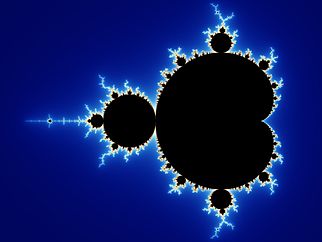

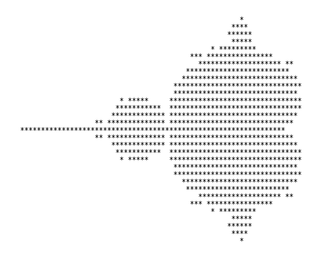



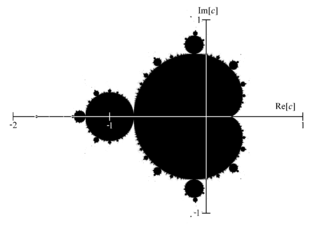

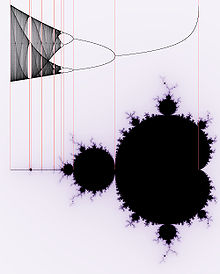
![z\mapsto \lambda z(1-z),\quad \lambda\in[1,4].\,](e/14ea2bcd4986ea856f321c077a157def.png)

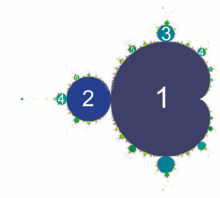


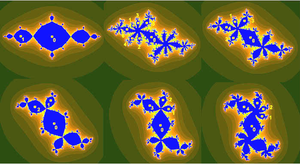




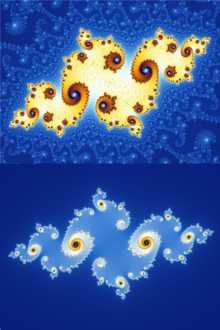
 ,
, 